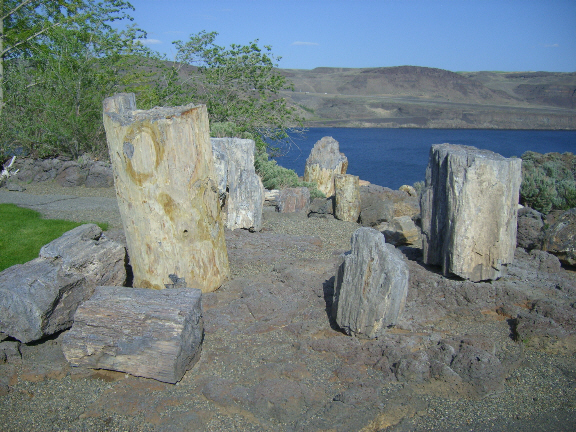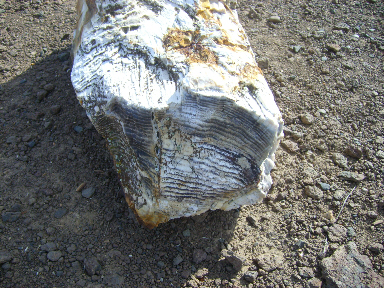
Ginkgo Petrified Forest State Park contains the remains
of one of the most unusual fossil forests in the world. It was set
aside as a historic preserve in the 1930s, after highway
construction crews working on the Vantage Road unearthed what
proved to be some of the rarest forms of petrified wood ever found.
Located one mile north of Vantage, near the geographic center of
Washington State, the park is now a registered national natural
landmark.
Trees of Stone
The “trees of stone” are a reminder of the fact that
central Washington was once vastly different from what it is today.
Million of years ago, during what geologists call the Miocene
Period, the region was wet and humid, dominated by swamps and
shallow lakes surrounded by forests. Species of both broadleaf and
upland conifers ended up buried in the mud of small lakes and
pools. Later, a volcanic fissure in southeastern Washington sent
floods of molten lava across the Columbia Plateau, leveling the
landscape and destroying the standing plants and trees. However,
the waterlogged, mud-covered trees were left intact. When lava from
the “Ginkgo Flow” contacted the water, it formed pillow
basalt that further protected the trees. Entombed in basalt, the
wood slowly began a chemical transformation. As Ann Saling explains
in The Great Northwest Nature Factbook, buried wood usually decays,
but when the groundwater contains enough silica (picked up from
volcanic ash) and other minerals, the minerals penetrate the wood
in a process known as petrifaction. Some wood remains, visible
under a microscope, but most is replaced by silica. Other minerals
and compounds in the groundwater also percolate through the wood,
adding brilliant color patterns. Over time, the wood becomes
stone.
To Log This Earthcache:
Go to the following listed waypoints and write down the required
information. Send your answers to me via email. If your answers are
correct, you may log a Find. Logs posted with any of the answers or
with the wrong information will be deleted.
Waypoint 1: N46 57.285 W119 59.271 This is the site of
the Gingko Petrified Forest Interpretive Center. When was this area covered in lava and how many square
miles were covered? There is a display here of several
petrified logs. Be sure to go inside the interpretive center to
learn more about the Ginkgo petrified forest.
To get the remaining answers, you will need to drive about 2
miles west on the Old Vantage Highway to an Interpretive Trail.
There you will hike on a well groomed trail to see logs of various
species partially unearthed and available for public viewing. From
the parking area, hike to waypoints 2, 3, and 4 and gather the
required information. Please stay on the designated trails. Total
round trip distance is 1.5 miles.
Waypoint 2: N46 56.975 W120 02.258 What is the species of this petrified
log?
Waypoint 3: N46 56.932 W120 02.411 What is the species of this petrified
log?
Waypoint 4: N46 57.056 W120 02.452 What is the species of this petrified log?
Please note the following park rules and other
warnings:
1) Pets must be on a leash at all times.
2) Bicycles are not allowed on the interpretive trails.
3) Bring your own water to the hiking trail.
4) No collecting petrified wood on any state park land.
5) This is rattlesnake country. Look and listen for snakes and
be cautious.
Enjoy your visit at the Ginkgo Petrified Forest!
